It looks like you're using an Ad Blocker.
Please white-list or disable AboveTopSecret.com in your ad-blocking tool.
Thank you.
Some features of ATS will be disabled while you continue to use an ad-blocker.
share:
I'm going to be looking here at the Minoan White Goddess and her female companions, the whiteness needs emphasis in that this is the primary mode of
recognition for these figures, in paintings were the general Minoan populace is seen as of a ruddy brown colouring...the Whiteness hence defines
her.
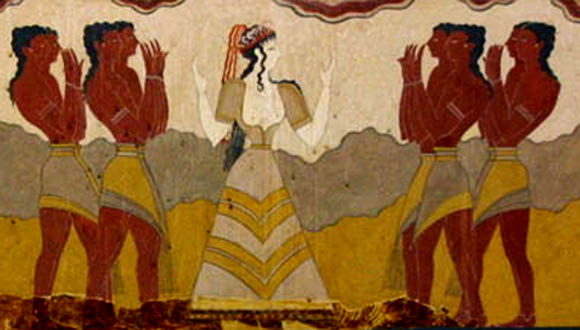
It isn't simply the case that it was conventional to depict women paler, that this was cosmetic, or they didn't get outside much. As can be seen below, expanding the above scene, the White Goddess takes centre stage, yet there is another white woman amongst a group of other women to the left, differentiated in not only her colouring, but also hair style and dress.

Academic considerations on who these figures are, whether Priestesses or Goddesses are few and far between and sketchy, little is understood or worth quoting, so i can only make my own proposals.

My general hypothesis is this, that these female figures are Goddesses, that they live and move amongst the people in a most hands on manner, that their primary undertaking is that of ordering society, particularly with regards to the harvesting and manipulating of nature, to the extent of administering breeding and cultivation programmes...and ruling through the power of her bared breasts, which is to say nurturing and nourishing the populace, as well as affording sensual delights.
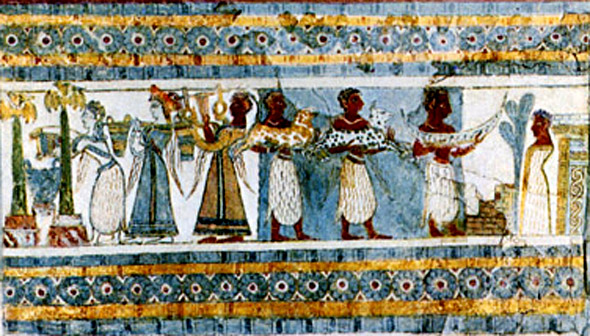
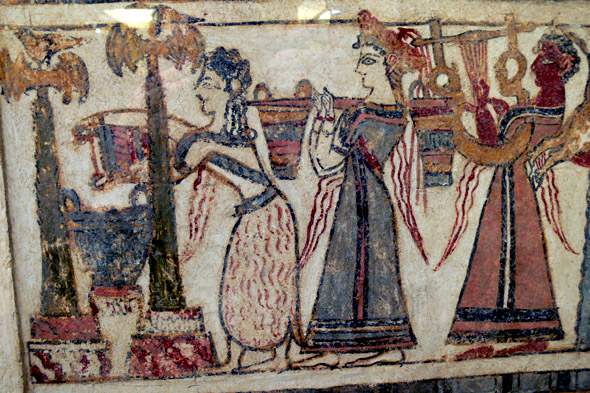
The background to this hypothesis is what i've previously considered for The Neolithic Breeding Programmes, and how this was conceived as under the auspices of a Queen Bee type figure, and a hive mentality amongst the general populace, the Minoan Goddess is very much a Bee Goddess.
Also i shall be suggesting a basis for the inter-relationship of the Goddess type figures, and their activities, along the lines of the Sumerian cult of Inanna and Ninsubur, and their establishment of a central procreation establishment within the E-Anna at Uruk, as in Uruk Rises Again
There is a good deal involved then, and i'll start by looking at the pictorial evidence of two close companions, as in Inanna and her Minister Ninsubur, these would represent in Sumeria Venus the Evening star and Morning star respectively, from a time when these were given as two seperate female Deities.
A first example then, these two companion Goddesses are seen collecting saffron;
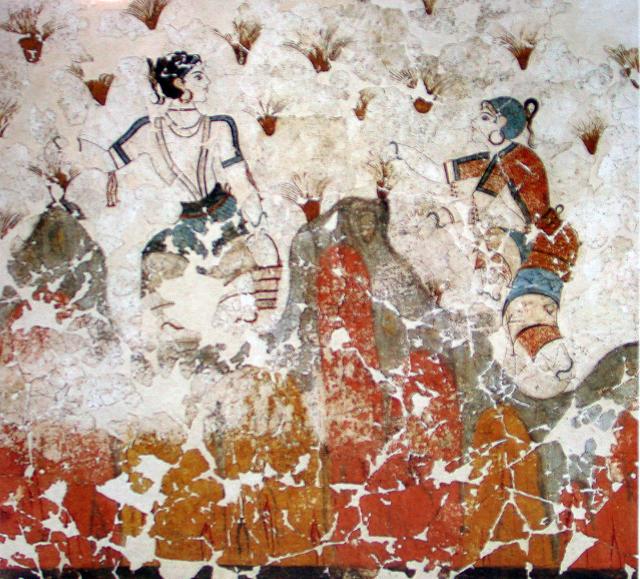
A second example, the primary of the two (Inanna in Sumer) is seated upon her throne recieving a blue monkey, her first Minister is in attendance;
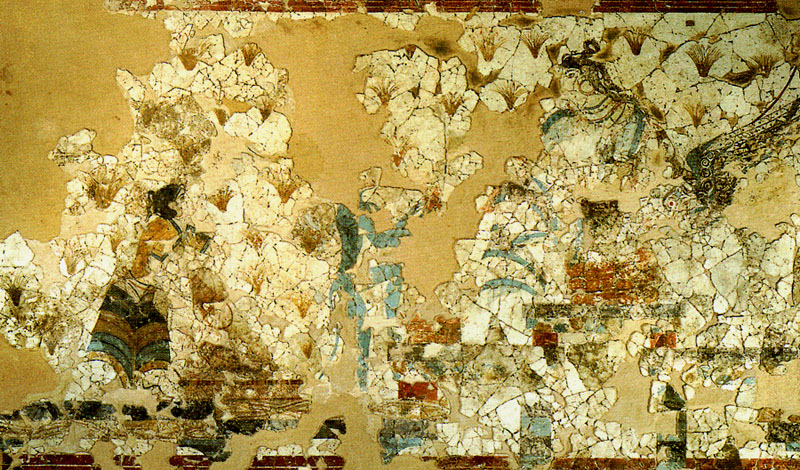
This is for those who want to see more of the monkeys...
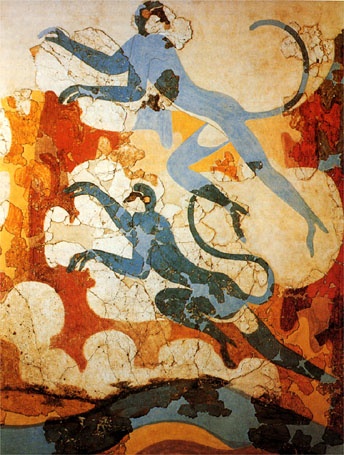
In a third example the primary Goddess is preparing to sacrifice a bull, symbolic of all things masculine, her first Minister is doing the neccesary auspicious offerings and oblutions.
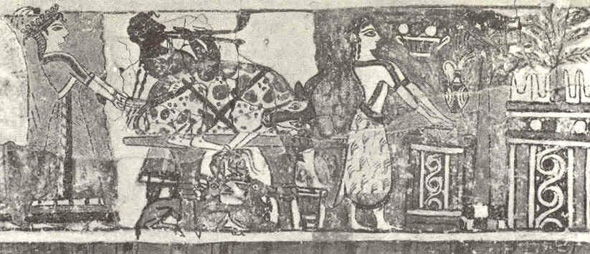
So i think that pairing can be identified, the first Minister would be the other white woman seen on the first fresco. That these were stellar Deities can be evidenced from illustrations such as these;
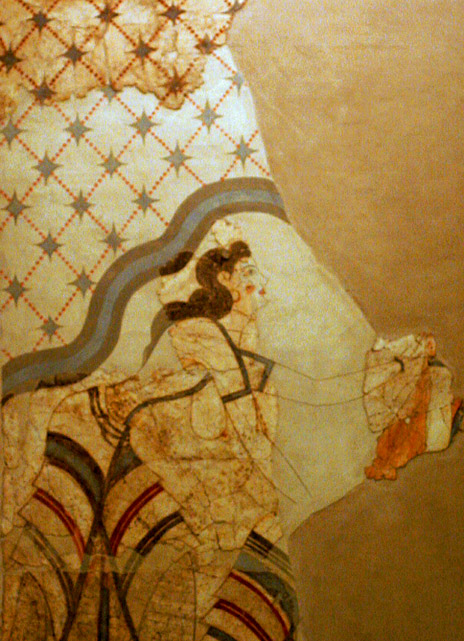

Were they are seen at opposite ends of a winding waterway, beneath the Heavenly stars, which are set into an idealized geometric pattern, that bears comparison to hive iconography.
At this point we shall need to consider a third sister, as in Sumer with Inanna and Ninsubur, there was also an Underworld Goddess, Erishkagal, a sister, who completed a triple Goddess package, a star of Morning and of Evening, and a sister that ruled Midnight.
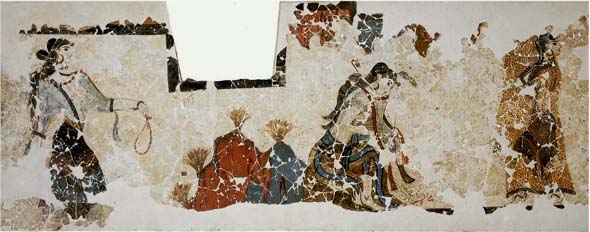
This triple aspect is seen in the blue Ladies fresco;
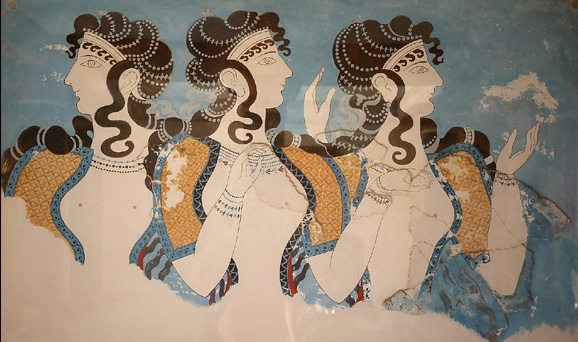
And here;
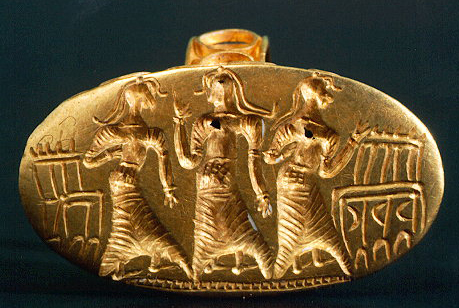
And here, though this might represent the three becoming singular;
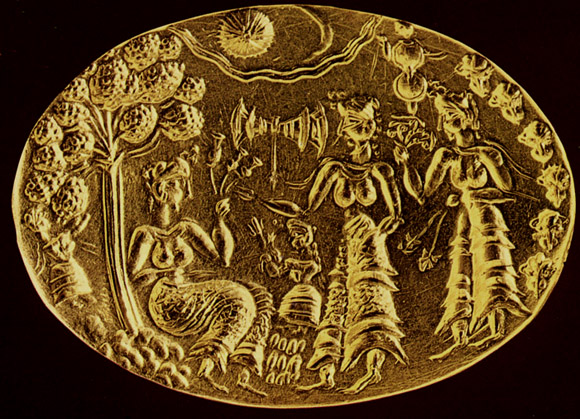
As would be the case here, were the Morning and Evening star are to the left, the Midnight sister to the right, the totality central.
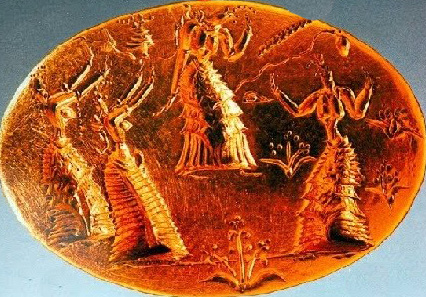
Having established then that the female figures are very much Goddesses, lets return to their involvement within Minoan Society, below we see the primary Goddess and her first Minister over seeing the herds, the city council, the army, the tree of Life, the Arc of the Heavens, pretty much everything;
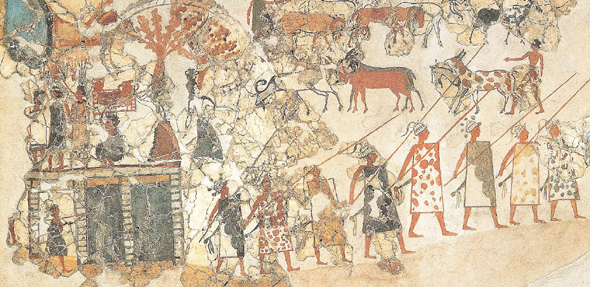
Here's another city scene were the game of spot the smiling white Goddess needs to be played;

Here she can be found in her double and triple aspects, at cultic sites within the city;

So she is seen as ever present and all important.
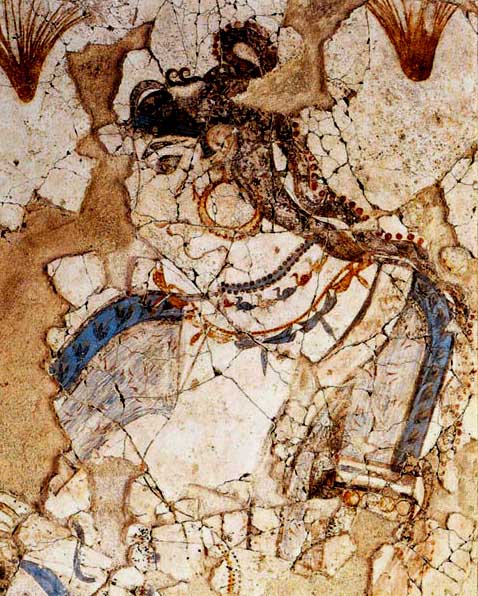
Having looked at the religious triple Goddess aspect through comparison with Sumer it will be interesting to elaborate upon that, and consider whether there was also the same concern with star gates, celestial portals of the horizon, which the Goddesses emerged from and into.

The above pictorial evidence would suggest so, the two portals at either horizon, it also suggests there was a similar cult of the Male lover that is taken into the Underworld as a replacement, as in the Dumuzi mythos, and the lamenting Goddess that facilitates seasonal return.
In short then it was seemingly the very same Goddess that ruled over the Minoans that ruled within the E-Anna of Uruk...
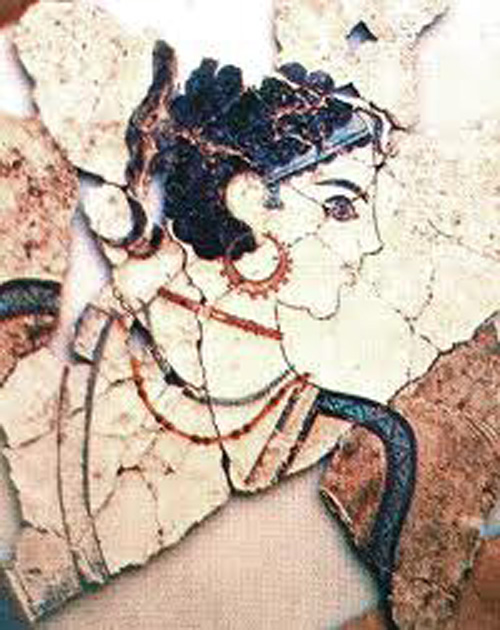
And it has to be said she ruled there very well and kept all Daimons on their best behaviour.
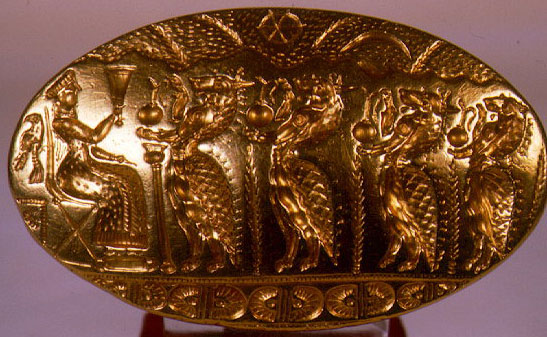
OOnsideration also needs to be given to the importance of their cultivation and collecting of Saffron,

lib.haifa.ac.il...
www.studyblue.com...
minoablog.blogspot.co.uk...

It isn't simply the case that it was conventional to depict women paler, that this was cosmetic, or they didn't get outside much. As can be seen below, expanding the above scene, the White Goddess takes centre stage, yet there is another white woman amongst a group of other women to the left, differentiated in not only her colouring, but also hair style and dress.

Academic considerations on who these figures are, whether Priestesses or Goddesses are few and far between and sketchy, little is understood or worth quoting, so i can only make my own proposals.

My general hypothesis is this, that these female figures are Goddesses, that they live and move amongst the people in a most hands on manner, that their primary undertaking is that of ordering society, particularly with regards to the harvesting and manipulating of nature, to the extent of administering breeding and cultivation programmes...and ruling through the power of her bared breasts, which is to say nurturing and nourishing the populace, as well as affording sensual delights.


The background to this hypothesis is what i've previously considered for The Neolithic Breeding Programmes, and how this was conceived as under the auspices of a Queen Bee type figure, and a hive mentality amongst the general populace, the Minoan Goddess is very much a Bee Goddess.
Also i shall be suggesting a basis for the inter-relationship of the Goddess type figures, and their activities, along the lines of the Sumerian cult of Inanna and Ninsubur, and their establishment of a central procreation establishment within the E-Anna at Uruk, as in Uruk Rises Again
There is a good deal involved then, and i'll start by looking at the pictorial evidence of two close companions, as in Inanna and her Minister Ninsubur, these would represent in Sumeria Venus the Evening star and Morning star respectively, from a time when these were given as two seperate female Deities.
A first example then, these two companion Goddesses are seen collecting saffron;

A second example, the primary of the two (Inanna in Sumer) is seated upon her throne recieving a blue monkey, her first Minister is in attendance;

This is for those who want to see more of the monkeys...

In a third example the primary Goddess is preparing to sacrifice a bull, symbolic of all things masculine, her first Minister is doing the neccesary auspicious offerings and oblutions.

So i think that pairing can be identified, the first Minister would be the other white woman seen on the first fresco. That these were stellar Deities can be evidenced from illustrations such as these;


Were they are seen at opposite ends of a winding waterway, beneath the Heavenly stars, which are set into an idealized geometric pattern, that bears comparison to hive iconography.
At this point we shall need to consider a third sister, as in Sumer with Inanna and Ninsubur, there was also an Underworld Goddess, Erishkagal, a sister, who completed a triple Goddess package, a star of Morning and of Evening, and a sister that ruled Midnight.

This triple aspect is seen in the blue Ladies fresco;

And here;

And here, though this might represent the three becoming singular;

As would be the case here, were the Morning and Evening star are to the left, the Midnight sister to the right, the totality central.

Having established then that the female figures are very much Goddesses, lets return to their involvement within Minoan Society, below we see the primary Goddess and her first Minister over seeing the herds, the city council, the army, the tree of Life, the Arc of the Heavens, pretty much everything;

Here's another city scene were the game of spot the smiling white Goddess needs to be played;

Here she can be found in her double and triple aspects, at cultic sites within the city;

So she is seen as ever present and all important.

Having looked at the religious triple Goddess aspect through comparison with Sumer it will be interesting to elaborate upon that, and consider whether there was also the same concern with star gates, celestial portals of the horizon, which the Goddesses emerged from and into.

The above pictorial evidence would suggest so, the two portals at either horizon, it also suggests there was a similar cult of the Male lover that is taken into the Underworld as a replacement, as in the Dumuzi mythos, and the lamenting Goddess that facilitates seasonal return.
In short then it was seemingly the very same Goddess that ruled over the Minoans that ruled within the E-Anna of Uruk...

And it has to be said she ruled there very well and kept all Daimons on their best behaviour.

OOnsideration also needs to be given to the importance of their cultivation and collecting of Saffron,
Scented flowers have long scarlet stigmas and the female parts are handpicked from each flower, male parts of no culinary value. Each flower has only three stigmas, over 14,000 of which are dried over charcoal fires to yield one ounce of saffron.
In the Bronze Age Minoan culture, saffron had religious associations and provided a flourishing trade. One of the first historic references of saffron comes from Ancient Egypt and Rome where the stigmas, were used as hair and fabric dye, in perfumes, as a drug, as well as for culinary purposes. It was used by Cleopatra and other Pharaons as an aromatic and seductive essence, and to make ablutions in temples. Ancient Egyptians sacrificed cakes of saffron to their gods.
During the Renaissance, Venice was the most important commercial center for saffron. During that time saffron was worth its weight in gold, and till today it is still
It is believed that saffron crocus originally grew nowhere but on the isle of Crete as a triploid sport of a Greek species Crocus cartwrightianus. The triploid crocus is sterile & it reproduces only by offsets on the corms. It cannot spread naturally, but declines if not dug up ever other year or so & the corms divided. That it even so spread throughout Europe & India & eventually into China was due to ancient routes of IndoEuropean traders. One must suppose that the priestesses who grew it attempted to keep cultivation methods secret

When Demeter first saw spring's bright yellow crocuses, she was angered, demanding who had disobeyed her edict that nothing flourishes until Persephone was restored to her side. The crocuses themselves replied, "But the Maid is coming!" Demeter in a dither of excitement dawned a mantle made of white crocuses in order to greet her returning daughter, who rose out of the ground in the circle of sunny yellow blooms. These pure yellow crocuses were probably the natural wild Golden Crocus
lib.haifa.ac.il...
www.studyblue.com...
minoablog.blogspot.co.uk...
edit on 20-5-2013 by Kantzveldt because: (no reason given)
Impressive tie-in to the Sumerian Goddesses!
Years ago, I bought a book about the Minoan people, because I read that they were somewhat related to Native Americans - and I found that interesting in and of itself.
However, I lost that book during one of my countless moves from apartment to apartment --- wish I remembered what it was called...
Great little write up on the White Sistah's (Snake Goddess) of Crete. Thanks for bringing this topic back up for me... now I have to track down that book I lost and start doing some research of my own... finish what I started, and what you apparently have a GREAT head start on!
Awesome job Kantzveldt!
Ess & Eff for you!
And out of curiosity...

Years ago, I bought a book about the Minoan people, because I read that they were somewhat related to Native Americans - and I found that interesting in and of itself.
However, I lost that book during one of my countless moves from apartment to apartment --- wish I remembered what it was called...
Great little write up on the White Sistah's (Snake Goddess) of Crete. Thanks for bringing this topic back up for me... now I have to track down that book I lost and start doing some research of my own... finish what I started, and what you apparently have a GREAT head start on!
Awesome job Kantzveldt!
Ess & Eff for you!
And out of curiosity...

I like reading about the old gods and goddesses. When I was young I took out every book in the library that had anything at all to do with any and
all gods and goddesses, studying what was known about them. I have read the bible more than a few times to learn what it had to offer on this subject
also. Beats listening to the sermons in church I am perfectly capable of understanding what the bible says, I don't need to listen to
everyone's different interpretations of it, although it is good to know how others interpret this book so you can use the bible along with
rationality to combat their off the wall interpretations if they exist.
These old religions, like the one of the Minoans, had a great influence on the formation of Christianity and the Bible. People cannot see the similarities that are there but instead condemned them through history by the differences they had. S&F
These old religions, like the one of the Minoans, had a great influence on the formation of Christianity and the Bible. People cannot see the similarities that are there but instead condemned them through history by the differences they had. S&F
reply to post by the_philth
Thanks, the snaake symbolism wret to the inter-connectivity of the Horizons, and the general concern with symmetry, as in the double axe symbolism, the winged birds and bees, the Morning and Evening stars.
Is she weird, is she white, is she promised to the night...very much so.
reply to post by rickymouse
Minoan society seems to me to be the only one that was ever absolutely Matriarchal, a Theocracy directly ruled by female Divinities, the traditions did continue in certain aspects and incorporated into various religions and cultures, but it was never really the same.
Thanks, the snaake symbolism wret to the inter-connectivity of the Horizons, and the general concern with symmetry, as in the double axe symbolism, the winged birds and bees, the Morning and Evening stars.
Is she weird, is she white, is she promised to the night...very much so.
reply to post by rickymouse
Minoan society seems to me to be the only one that was ever absolutely Matriarchal, a Theocracy directly ruled by female Divinities, the traditions did continue in certain aspects and incorporated into various religions and cultures, but it was never really the same.
edit on 20-5-2013 by Kantzveldt because: (no reason given)
Nice thread
I came across this article during the week about the Minoans origins.
Mysterious Minoans Were European, DNA Finds.
Scientists compared DNA from over 4000 skeletons with genetic material from people living throughout Europe and Africa in the past and today. They came to the conclusion that they were very similar to Neolithic Europeans and very similar to present day-Cretans," residents of the Mediterranean island of Crete.
I came across this article during the week about the Minoans origins.
Mysterious Minoans Were European, DNA Finds.
Scientists compared DNA from over 4000 skeletons with genetic material from people living throughout Europe and Africa in the past and today. They came to the conclusion that they were very similar to Neolithic Europeans and very similar to present day-Cretans," residents of the Mediterranean island of Crete.
reply to post by Kantzveldt
Whenever I look at ancient wall paintings I compare the colour they depict males in contrast to females, it would seem to me that in your images females are depicted white whilst males are depicted ruddy. Same in Egyptian wall paintings!
Whenever I look at ancient wall paintings I compare the colour they depict males in contrast to females, it would seem to me that in your images females are depicted white whilst males are depicted ruddy. Same in Egyptian wall paintings!
reply to post by LUXUS
I did mention i'd taken that possible convention into account, but there are plenty of Minoan women in the pictures the regular ruddy brown, the white females are always in the context of Divinity.
reply to post by Lady_Tuatha
That's true, there is shared common ancestry from the core Neolithic region, though perhaps the Cretans of 4,000 years ago were generally a little darker in complexion than the present, according to what is seen in the frescoes.
I did mention i'd taken that possible convention into account, but there are plenty of Minoan women in the pictures the regular ruddy brown, the white females are always in the context of Divinity.
reply to post by Lady_Tuatha
That's true, there is shared common ancestry from the core Neolithic region, though perhaps the Cretans of 4,000 years ago were generally a little darker in complexion than the present, according to what is seen in the frescoes.
edit on 20-5-2013 by Kantzveldt because: (no reason given)
reply to post by Kantzveldt
This is going to sound COMPLETELY off topic but have you ever seen the movie Plan 10 from Outer Space (not to bee confused with Plan 9...) It is a silly movie but it made me think about things in a whole new light.
I think you will find it interesting as I believe there is a more modern day connection to the White Goddess. Centering around a place called Deseret better known as Utah...
This was further confirmed with a brief search for the book that the_philth was looking for Linking Native Americans to the Minoans read to the end and you will hopefully get the connection. If not look up the meaning of Deseret...
A rabbit hole is in the making I think at least for me...
This is going to sound COMPLETELY off topic but have you ever seen the movie Plan 10 from Outer Space (not to bee confused with Plan 9...) It is a silly movie but it made me think about things in a whole new light.
I think you will find it interesting as I believe there is a more modern day connection to the White Goddess. Centering around a place called Deseret better known as Utah...
This was further confirmed with a brief search for the book that the_philth was looking for Linking Native Americans to the Minoans read to the end and you will hopefully get the connection. If not look up the meaning of Deseret...
A rabbit hole is in the making I think at least for me...
Beatiful info compilation. One of the great tragedies of history that they happened to settle right on top of a volcano S&F
reply to post by Kantzveldt
I've always considered the Minoan snake goddess to be an iteration of Inanna. In fact, it almost seems that the Minoan version was a matriarchal reboot of her.
I like to compare that reboot to the modern reconstructionist reboots we have today. Thousand(s) of years passed between the two cultures and now they are thousands of years in the past to us.
I've always considered the Minoan snake goddess to be an iteration of Inanna. In fact, it almost seems that the Minoan version was a matriarchal reboot of her.
I like to compare that reboot to the modern reconstructionist reboots we have today. Thousand(s) of years passed between the two cultures and now they are thousands of years in the past to us.
reply to post by Kantzveldt
Lovely thread! And one of my favourite subject matters. I assume you have read Robert Graves's The White Goddess...in case not, I will say no more, and allow you that pleasure for yourself.
The force of the Moon though was once wholly recognised and appreciated, especially by women, who used a lunar calendar in order to predict their own, as well as the land's fertility, and the optimum times to plant seeds in both. The vast majority of the stone circles that have been thoroughly investigated, including Stone Henge, are accepted to have begun their existence as lunar calendars, and the rivers, whose floods and tides, are influenced by the cycles of the Moon were under the protection of the White Goddess, and generally assumed aspects as lesser goddesses, or hand maidens of the Lunar Goddess. The further we moved into the worship of the Sun, the more masculine elements assumed dominance, and the White Goddess assumed less importance ritually, though certainly not in actuality. We are as dependent on her as we are on him.
Lovely thread! And one of my favourite subject matters. I assume you have read Robert Graves's The White Goddess...in case not, I will say no more, and allow you that pleasure for yourself.
The force of the Moon though was once wholly recognised and appreciated, especially by women, who used a lunar calendar in order to predict their own, as well as the land's fertility, and the optimum times to plant seeds in both. The vast majority of the stone circles that have been thoroughly investigated, including Stone Henge, are accepted to have begun their existence as lunar calendars, and the rivers, whose floods and tides, are influenced by the cycles of the Moon were under the protection of the White Goddess, and generally assumed aspects as lesser goddesses, or hand maidens of the Lunar Goddess. The further we moved into the worship of the Sun, the more masculine elements assumed dominance, and the White Goddess assumed less importance ritually, though certainly not in actuality. We are as dependent on her as we are on him.
reply to post by Cuervo
Though i note the similarities with Sumerian convention i don't think the Minoan traditions owe anything to Sumer, but that rather this is the essential religion from the core Neolithic region, from which these islands were the first to be settled, some 9,000 years ago.
The Inanna tradition, as found amongst the Dravidians of Iraq and Iran, i would also trace back to the same Neolityhic source, the essential developments of the Neolithic period, cultivation and the breeding and domestication of livestock, being critical aspects of this cult.
reply to post by KilgoreTrout
I have read it, some time ago, and you're right that lunar symbolism will in every sense reflect the white qualities of these Goddesses, that also ruled by night as shining Venus.
There is also the concern with collecting the golden saffron, which is commonly seen in Indo-European tradition as related to the sun, fire. gold, and this light is that which illuminates the moon, so in Minoan tradition the Goddesses can be seen in conjunction with both the sun and the moon...all bases covered.
reply to post by abeverage
I haven't no, i'll have a look out for it. It seems to be quite some rabbit hole that is being suggested, i'm not sure i'm following exactly, though i note Deseret related to honey and bees as explained in Mormon tradition, and the Minoan Goddesses could be seen as bees.
i know the secret of the bees...
reply to post by PsykoOps
Thanks, yes Thera was an unfortunate location for a colony, but then again many of the fresco seen here are from there as the site is well preserved and still being uncovered and understood.
Though i note the similarities with Sumerian convention i don't think the Minoan traditions owe anything to Sumer, but that rather this is the essential religion from the core Neolithic region, from which these islands were the first to be settled, some 9,000 years ago.
The Inanna tradition, as found amongst the Dravidians of Iraq and Iran, i would also trace back to the same Neolityhic source, the essential developments of the Neolithic period, cultivation and the breeding and domestication of livestock, being critical aspects of this cult.
reply to post by KilgoreTrout
I have read it, some time ago, and you're right that lunar symbolism will in every sense reflect the white qualities of these Goddesses, that also ruled by night as shining Venus.
There is also the concern with collecting the golden saffron, which is commonly seen in Indo-European tradition as related to the sun, fire. gold, and this light is that which illuminates the moon, so in Minoan tradition the Goddesses can be seen in conjunction with both the sun and the moon...all bases covered.
reply to post by abeverage
I haven't no, i'll have a look out for it. It seems to be quite some rabbit hole that is being suggested, i'm not sure i'm following exactly, though i note Deseret related to honey and bees as explained in Mormon tradition, and the Minoan Goddesses could be seen as bees.
i know the secret of the bees...
reply to post by PsykoOps
Thanks, yes Thera was an unfortunate location for a colony, but then again many of the fresco seen here are from there as the site is well preserved and still being uncovered and understood.
edit on 20-5-2013 by Kantzveldt because: (no reason given)
Here this should help you in it you will find connections to the Minoans, The Pure Mother
Bee, more bees, the trinity of bee goddesses, and finally with Mayans (who Mormons believe are the Nephites and the Lamanites from the Jaridites who
came to America bringing with them...The Bee). Mormons also believe in a Heavenly mother but that is another story full of Masons and their secrets to
me much of this is relating to a hidden religion of Goddess worship that is still practiced...
edit on 20-5-2013 by abeverage because: (no
reason given)
reply to post by abeverage
Thanks, however my first thread here was on the forgotten bee tradition;
The Forgotten Ones
The 'aliens' are bees, no doubt about that, they have a hive mentality and a Queen.
As for Kolob...
Tu bu, tu bu (sound of the bees)
I drink the wine of gods my lord
to therefore the insects of the lady bee Colel Cab
to lady black rock, to lady rain
tu bu, tu bu, tu bu the wine of the lord god thirteen days,
thirteen nights thirteen times downwards then return our insects
certainly of the beautiful (lady) hole lord
where therefore I place the holy virgin wine
in the path of the lady bee, lady peten
spring of springs my lord
to the beautiful lady foreign divine queen lord
www.famsi.org...
Thanks, however my first thread here was on the forgotten bee tradition;
The Forgotten Ones
The 'aliens' are bees, no doubt about that, they have a hive mentality and a Queen.
As for Kolob...
Tu bu, tu bu (sound of the bees)
I drink the wine of gods my lord
to therefore the insects of the lady bee Colel Cab
to lady black rock, to lady rain
tu bu, tu bu, tu bu the wine of the lord god thirteen days,
thirteen nights thirteen times downwards then return our insects
certainly of the beautiful (lady) hole lord
where therefore I place the holy virgin wine
in the path of the lady bee, lady peten
spring of springs my lord
to the beautiful lady foreign divine queen lord
www.famsi.org...
edit on 20-5-2013 by Kantzveldt because: (no reason given)
reply to post by Kantzveldt
The color scheme used by the Minoans is interesting because females and males in ancient Egyptian artwork followed a similar color scheme. Males are normally painted dark-brown or reddish-brown, and females are normally painted light-yellow (during the Old Kingdom) or yellowish-brown/brown (during the Middle Kingdom/New Kingdom).
I wonder if the highly stylized and symbolic Egyptian artwork influenced the Minoans' stylizations because they did come into contact with each other...
"Minoan ceramics are found in Egyptian cities and the Minoans imported several items from Egypt, especially papyrus, as well as architectural and artistic ideas."
The color scheme used by the Minoans is interesting because females and males in ancient Egyptian artwork followed a similar color scheme. Males are normally painted dark-brown or reddish-brown, and females are normally painted light-yellow (during the Old Kingdom) or yellowish-brown/brown (during the Middle Kingdom/New Kingdom).
I wonder if the highly stylized and symbolic Egyptian artwork influenced the Minoans' stylizations because they did come into contact with each other...
"Minoan ceramics are found in Egyptian cities and the Minoans imported several items from Egypt, especially papyrus, as well as architectural and artistic ideas."
edit on 5/20/2013 by Nacirema because: (no reason given)
reply to post by Kantzveldt
Kantzveldt, very well put together data presentation on the Ancient Goddesses you seem to carry a professional influence with these types of threads and 1 has enjoyed them thus far, kind of remind 1 of another member here who is good for compiling ancient data threads. Keep up the good work and as the data is compiled from various sources the truth of these deities and others related to the Region of Sumer will hopefully be shared.
LOVE LIGHT ETERNIA*******
Kantzveldt, very well put together data presentation on the Ancient Goddesses you seem to carry a professional influence with these types of threads and 1 has enjoyed them thus far, kind of remind 1 of another member here who is good for compiling ancient data threads. Keep up the good work and as the data is compiled from various sources the truth of these deities and others related to the Region of Sumer will hopefully be shared.
LOVE LIGHT ETERNIA*******
reply to post by Kantzveldt
www.halexandria.org...
To appreciate the continuing sage of Enki versus Enlil, it is instructive to note their place in the Sumerian Family Tree, aka the “Grand Assembly of the Anunnaki”.
Marduk (who would become the god of the Babylonians) was Enki’s first born, and that of Enki’s wife, the goddess Damkina. Enki’s other wife was his half-sister, Nin-khursag (meaning “Mountain Queen”), the Lady of Life, also known as Nin-mah, the Great Lady.
Enlil was also espoused to Nin-khursag and their son was Ninurta (Ningirsu), the Mighty Hunter. By another wife, Ninlil (Sud), Enlil had a second son, Nanna (Suen), known as the Bright One. Nanna and his wife, Ningal, were the parents of Inanna (who was called Ishtar by the Babylonians), and who married the Shepherd King Dumu-zi (the latter given in the Semitic Old Testament book of Ezekiel 8:14 as Tammuz).
Another son of Enlil and Ninlil was Nergal (Meslamtaea), King of the Underworld. He married Eresh-kigal, the Queen of the Netherworld, the daughter of Nanna and Ningal (i.e. Inanna’s sister), and the mother of Lilith (who became handmaiden to Inanna, her maternal aunt). Lilith is also notorious as the first wife of Adam, but it was Lilith who rejected him (and thus incurred the wrath of every reject-worthy male on the planet).
www.halexandria.org...
Originally posted by Turkenstein
reply to post by LUXUS
could you explain your avatar pic and what it is from?? Please?
Lord Krishnas uncle was jealous of him so he tried many times to kill lord krishna, finally he arranged a wrestling match that he was sure would end in his death. Lord krishna was small but he was full of shakti (spiritual powers). The result was that the larger wrestler paid with his life and lost to krishna. The moral of the story is that spirit rules over matter. You can see a better pic here :
yadavhistory.com...
reply to post by Kantzveldt
I'm not terribly convinced with the Sumerian ties nor of the identification of all white figures as goddesses, because in numerous examples women of various statuses are shown as white-skinned. (here, and here ) -- goddesses did not participate in the sport.
While they were famous traders, they don't seem to have exported their deities to the other countries they interacted with (including Egypt) or picked up gods from these other countries (like Egyptian gods.) -- any more than other trading nations (like Great Britain) adopted deities from the people they traded with (modified Christianity to reflect things they learned from the Hindus... British didn't do that, and there's no real reason why the Minoans would do that.)
I don't see any reason for them to suddenly make an exception for Sumeria/Ur/Babylon.
Nor was Sumeria a colony of the Minoans. Generally where there's a blend of gods, you see areas where two cultures are blending together.
I think you need far stronger evidence to support your idea. I'm not seeing a lot of scholarly papers discussing trade and cultural influences between the two from archaeologists.
I'm not terribly convinced with the Sumerian ties nor of the identification of all white figures as goddesses, because in numerous examples women of various statuses are shown as white-skinned. (here, and here ) -- goddesses did not participate in the sport.
While they were famous traders, they don't seem to have exported their deities to the other countries they interacted with (including Egypt) or picked up gods from these other countries (like Egyptian gods.) -- any more than other trading nations (like Great Britain) adopted deities from the people they traded with (modified Christianity to reflect things they learned from the Hindus... British didn't do that, and there's no real reason why the Minoans would do that.)
I don't see any reason for them to suddenly make an exception for Sumeria/Ur/Babylon.
Nor was Sumeria a colony of the Minoans. Generally where there's a blend of gods, you see areas where two cultures are blending together.
I think you need far stronger evidence to support your idea. I'm not seeing a lot of scholarly papers discussing trade and cultural influences between the two from archaeologists.
new topics
-
I've realized something about Politics recently.
US Political Madness: 50 seconds ago -
France bans head coverings but allows Christianity to be mocked at Olympics.
Political Conspiracies: 2 hours ago -
Woo time it aint over yet
Paranormal Studies: 3 hours ago -
BIDEN-HARRIS Preparing to Also Make Us Pay For Illegal-Aliens to Attend College Prep Programs.
Political Ideology: 6 hours ago -
The Main Question and A Bonus Question
General Conspiracies: 8 hours ago -
Is Kamala Good for America ?
Political Issues: 8 hours ago -
The Most Crime Ridden Games Ever
World Sports: 8 hours ago -
A Preliminary Question
General Conspiracies: 9 hours ago -
Olympics France 2024 Opening Ceremony
World Sports: 9 hours ago -
Did Russia just attack a NATO nation?
The Gray Area: 11 hours ago
top topics
-
Warning Graphic Images – Close-up of DJT’s wounded ear to debunk naysayers
Dissecting Disinformation: 17 hours ago, 16 flags -
The Main Question and A Bonus Question
General Conspiracies: 8 hours ago, 13 flags -
Is Kamala Good for America ?
Political Issues: 8 hours ago, 12 flags -
Sinaloa Cartel co-founder ‘El Mayo’ taken into US custody
Other Current Events: 14 hours ago, 11 flags -
Brazil UFO July 2024
Aliens and UFOs: 13 hours ago, 9 flags -
Fasten your seatbelts!
2024 Elections: 15 hours ago, 9 flags -
BIDEN-HARRIS Preparing to Also Make Us Pay For Illegal-Aliens to Attend College Prep Programs.
Political Ideology: 6 hours ago, 9 flags -
Obamas endorse Kamala
2024 Elections: 14 hours ago, 8 flags -
Did Russia just attack a NATO nation?
The Gray Area: 11 hours ago, 6 flags -
The Most Crime Ridden Games Ever
World Sports: 8 hours ago, 5 flags
active topics
-
I've realized something about Politics recently.
US Political Madness • 0 • : GotterDameron23 -
France bans head coverings but allows Christianity to be mocked at Olympics.
Political Conspiracies • 14 • : SteamyAmerican -
Warning Graphic Images – Close-up of DJT’s wounded ear to debunk naysayers
Dissecting Disinformation • 100 • : cherokeetroy -
The threat of Communism is driving support to Trump.
US Political Madness • 124 • : namehere -
JD Vance Is the Least Liked VP Nominee in Decades, According to Polls
2024 Elections • 338 • : 777Vader -
Shooting Audio Visual Analysis, Butler, PA
Dissecting Disinformation • 121 • : kwaka -
The Main Question and A Bonus Question
General Conspiracies • 6 • : burntheships -
Did Russia just attack a NATO nation?
The Gray Area • 30 • : 777Vader -
Is Kamala Good for America ?
Political Issues • 185 • : frogs453 -
Would-be Assassin Crooks Geo-tracked to DC, FBI Center
US Political Madness • 63 • : 777Vader
